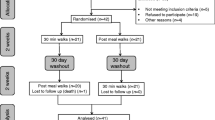Abstract
Purpose
Several guidelines have recently recommended exercise for prevention and treatment of type 2 diabetes. However, determining the optimum exercise conditions, e.g., the intensity, amount, frequency, and type of exercise, is difficult, particularly by patients themselves. We have investigated the acute effect of fast walking on postprandial blood glucose levels among patients with type 2 diabetes.
Methods
Fourteen patients diagnosed with type 2 diabetes at least 1 year previously were eligible for inclusion in this study during educational hospitalization. Three walking programs, natural walking (walking at a natural speed), 10 % fast walking, and 20 % fast walking, were performed 1 h after lunch in a randomized sequence with a washout period of 1 day. Walking time was 30 min in all the programs. Primary outcome was determined by self-monitoring of blood glucose. Blood glucose levels were measured before walking, after walking for 15 min, and at the end of walking. Heart rate and systolic and diastolic pressure were also measured for safety reasons.
Results
All the participants completed the study with no adverse effects. Compared with natural walking, fast walking markedly improved postprandial glucose excursion in an intensity-dependent manner without any adverse effects.
Conclusion
Fast walking acutely reduced postprandial blood glucose levels among patients with type 2 diabetes. Our method has major implications for the practice of diabetes education in clinical rehabilitation.

Similar content being viewed by others
References
Stumvoll M, Goldstein BJ, van Haeften TW. Type 2 diabetes: principles of pathogenesis and therapy. Lancet. 2005;365(9467):1333–46.
Stratton IM, Adler AI, Neil HA, Matthews DR, Manley SE, Cull CA, et al. Association of glycaemia with macrovascular and microvascular complications of type 2 diabetes (UKPDS 35): prospective observational study. BMJ. 2000;321(7258):405–12.
Moreno G, Mangione CM. Management of cardiovascular disease risk factors in older adults with type 2 diabetes mellitus: 2002–2012 literature review. J Am Geriatr Soc. 2013;61(11):2027–37.
Turner RC, Holman RR, Cull CA, Stratton IM, Matthews DR, Frighi V, et al. Intensive blood-glucose control with sulphonylureas or insulin compared with conventional treatment and risk of complications in patients with type 2 diabetes (UKPDS 33). Lancet. 1998;352(9131):837–53.
Stearne MR, Palmer SL, Hammersley MS, Franklin SL, Spivey RS, Levy JC, et al. Tight blood pressure control and risk of macrovascular and microvascular complications in type 2 diabetes: UKPDS 38. Brit Med J. 1998;317(7160):703–13.
Stewart KJ. Exercise training and the cardiovascular consequences of type 2 diabetes and hypertension: plausible mechanisms for improving cardiovascular health. JAMA, J Am Med Assoc. 2002;288(13):1622–31.
Colberg SR, Sigal RJ, Fernhall B, Regensteiner JG, Blissmer BJ, Rubin RR, et al. Exercise and type 2 diabetes: the American College of Sports Medicine and the American Diabetes Association: joint position statement. Diabetes Care. 2010;33(12):e147–67.
American Diabetes A. Standards of medical care in diabetes—2013. Diabetes Care. 2013;36(Suppl 1):S11–66.
Sone H, Tanaka S, Iimuro S, Tanaka S, Oida K, Yamasaki Y, et al. Long-term lifestyle intervention lowers the incidence of stroke in Japanese patients with type 2 diabetes: a nationwide multicentre randomised controlled trial (the Japan Diabetes Complications Study). Diabetologia. 2010;53(3):419–28.
Jeon CY, Lokken RP, Hu FB, van Dam RM. Physical activity of moderate intensity and risk of type 2 diabetes. Diabetes Care. 2007;30(3):744–52.
Morrato EH, Hill JO, Wyatt HR, Ghushchyan V, Sullivan PW. Physical activity in US adults with diabetes and at risk for developing diabetes, 2003. Diabetes Care. 2007;30(2):203–9.
Boule NG, Haddad E, Kenny GP, Wells GA, Sigal RJ. Effects of exercise on glycemic control and body mass in type 2 diabetes mellitus—a meta-analysis of controlled clinical trials. Jama J Am Med Assoc. 2001;286(10):1218–27.
Johnson ST, McCargar LJ, Bell GJ, Tudor-Locke C, Harber VJ, Bell RC. Walking faster: distilling a complex prescription for type 2 diabetes management through pedometry. Diabetes Care. 2006;29(7):1654–5.
Oberlin DJ, Mikus CR, Kearney ML, Hinton PS, Manrique C, Leidy HJ, et al. One bout of exercise alters free-living postprandial glycemia in type 2 diabetes. Med Sci Sports Exerc. 2014;46(2):232–8.
van der Heijden MM, van Dooren FE, Pop VJ, Pouwer F. Effects of exercise training on quality of life, symptoms of depression, symptoms of anxiety and emotional well-being in type 2 diabetes mellitus: a systematic review. Diabetologia. 2013;56(6):1210–25.
Garber CE, Blissmer B, Deschenes MR, Franklin BA, Lamonte MJ, Lee IM, et al. American College of Sports Medicine position stand. Quantity and quality of exercise for developing and maintaining cardiorespiratory, musculoskeletal, and neuromotor fitness in apparently healthy adults: guidance for prescribing exercise. Med Sci Sports Exerc. 2011;43(7):1334–59.
Johnson ST, Tudor-Locke C, McCargar LJ, Bell RC. Measuring habitual walking speed of people with type 2 diabetes: are they meeting recommendations? Diabetes Care. 2005;28(6):1503–4.
Miyai N, Arita M, Miyashita K, Morioka I, Shiraishi T, Nishio I. Blood pressure response to heart rate during exercise test and risk of future hypertension. Hypertension. 2002;39(3):761–6.
Benhalima K, Mathieu C. The role of blood glucose monitoring in non-insulin treated type 2 diabetes: what is the evidence? Prim Care Diabetes. 2012;6(3):179–85.
Acknowledgments
This work was partly supported with by Grant-in-Aid for Medical and Dental Research from General Incorporated Associations Kojinkai.
Conflict of interest
Authors KD, TE, NS, HM, YF, MM, and SK declare that they have no conflict of interest.
Ethical standard
All procedures followed were in accordance with the ethical standards of the responsible committee on human experimentation (institutional and national) and with the Helsinki Declaration of 1964 and later versions.
Informed consent
Informed consent was obtained from all patients before inclusion in the study.
Author information
Authors and Affiliations
Corresponding author
Additional information
K. Deguchi and T. Enishi contributed equally.
About this article
Cite this article
Deguchi, K., Enishi, T., Sato, N. et al. Acute effect of fast walking on postprandial blood glucose control in type 2 diabetes. Diabetol Int 7, 119–123 (2016). https://doi.org/10.1007/s13340-015-0217-z
Received:
Accepted:
Published:
Issue Date:
DOI: https://doi.org/10.1007/s13340-015-0217-z




